Discover the captivating world of bonsai trees collection of bonsai figs and junipers. These miniature wonders will bring a touch of nature and tranquility to your home or garden.
Bonsai figs, known for their lush foliage and graceful branches, add a sense of elegance and serenity to any space. With their distinctive aerial roots and ability to develop a majestic trunk, fig bonsai trees are a true marvel of nature.
Junipers, on the other hand, offer a unique charm with their delicate needle-like foliage and rugged bark. These resilient trees can be shaped into various forms, allowing you to create your own living masterpiece. Juniper bonsai trees are known for their timeless beauty and symbolize strength and longevity.

A wide selection of bonsai figs and junipers, carefully nurtured to ensure their health and quality. Whether you are a seasoned bonsai enthusiast or a beginner, you’ll find the perfect bonsai tree to suit your taste and skill level.
Transform your living space into an oasis of tranquility with these enchanting bonsai figs and junipers. Let the beauty and artistry of bonsai trees inspire and captivate you.
Brief explanation of bonsai as an ancient art form
Bonsai is an ancient art form that originated in China over a thousand years ago and was later refined in Japan. The word “bonsai” itself translates to “tree in a tray” or “planting in a shallow container.” It involves the cultivation and shaping of miniature trees in containers, creating a living work of art that reflects the beauty of nature in a small-scale form.
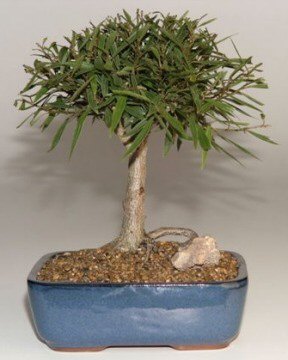
Willow Leaf Ficus Bonsai Tree-Medium
(Ficus Nerifolia/Salisafolia)
The practice of bonsai involves careful and deliberate techniques to control the growth, size, and appearance of the tree. It requires a deep understanding of horticulture, aesthetics, and patience. Bonsai artists aim to create a tree that mimics the shape and appearance of mature, full-sized trees found in nature.
Bonsai trees are not genetically dwarfed plants but are rather normal tree species that are trained and pruned to remain small and compact. The size and shape of the tree are achieved through various techniques such as pruning, wiring, and regular maintenance. By carefully controlling factors like root pruning, branch trimming, and foliage management, bonsai artists can create the illusion of an ancient, weathered tree that captures the essence of nature in a small-scale form.
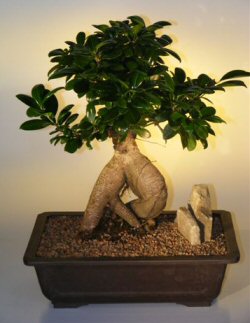
Ginseng Ficus Bonsai Tree – Extra Large
(ficus retusa)
from: Bonsai Boy of New York
The art of bonsai goes beyond just cultivating and maintaining the trees. It also emphasizes the harmony between the tree and its container, known as the bonsai pot. The choice of pot, its size, shape, color, and material, is carefully considered to complement the tree and enhance its overall aesthetic appeal.
Bonsai is not only a horticultural practice but also a form of artistic expression and cultural tradition. It requires a deep appreciation for nature, an understanding of the principles of design and aesthetics, and a commitment to the ongoing care and refinement of the tree.
Today, bonsai has gained popularity worldwide, with enthusiasts and practitioners from different cultures and backgrounds embracing this ancient art form. It is a way to connect with nature, express creativity, and cultivate a sense of tranquility and mindfulness.
Bonsai Figs and Junipers are two popular varieties
Bonsai Figs and Junipers are two popular varieties of bonsai trees that are widely appreciated by bonsai enthusiasts. Here’s an overview of each:
Explanation of the Ficus genus, which includes Bonsai Figs
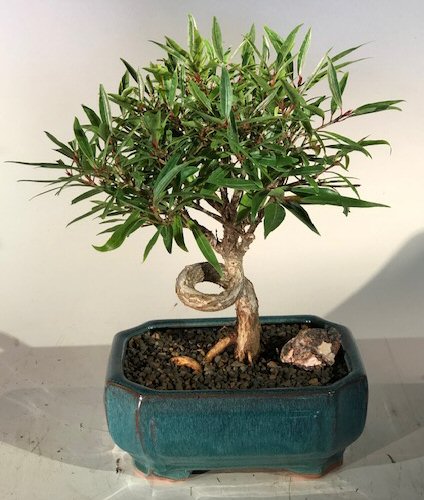
FREE SHIPPING ON THIS TREE
Willow Leaf Ficus Bonsai Tree – Medium
Coiled Trunk Style
(ficus nerifolia/salicafolia) – $57.00
from: Bonsai Boy of New York
Bonsai Figs belong to the Ficus genus, which includes a variety of fig tree species. They are highly favored for bonsai cultivation due to their unique characteristics and adaptability. Some popular species used for bonsai include the Ficus microcarpa, Ficus retusa, and Ficus benjamina. Bonsai Figs are known for their small, glossy leaves, which are well-suited for the miniature scale of bonsai. They often develop aerial roots, which add an intriguing visual element to the tree’s overall appearance.
These trees can also produce small fig fruits, although it may be challenging to achieve fruiting in a bonsai setting. Bonsai Figs are valued for their ability to tolerate a wide range of lighting conditions, making them suitable for indoor or outdoor cultivation. They require regular watering, allowing the soil to partially dry between waterings. Pruning and shaping techniques are commonly employed to create the desired bonsai form, including various styles such as informal upright, cascade, and broom.
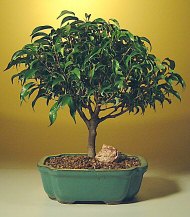
Ficus ‘Midnight’ Bonsai Tree- Large
(ficus benjamina ‘midnight’)
from: Bonsai Boy of New York
The Ficus genus is a diverse group of plants that belongs to the Moraceae family, commonly known as the fig family. It is one of the largest plant genera, comprising hundreds of species distributed across different regions of the world, including tropical and subtropical regions. Bonsai Figs are among the popular members of the Ficus genus that are commonly cultivated as bonsai trees.
Ficus trees are known for their attractive foliage, unique growth habits, and adaptability. They exhibit a wide range of leaf shapes, sizes, and textures, depending on the specific species. Bonsai Figs are particularly favored for bonsai cultivation due to their suitability for miniaturization and the ability to develop aerial roots.
Characteristics of Bonsai Figs, such as small leaves and aerial roots
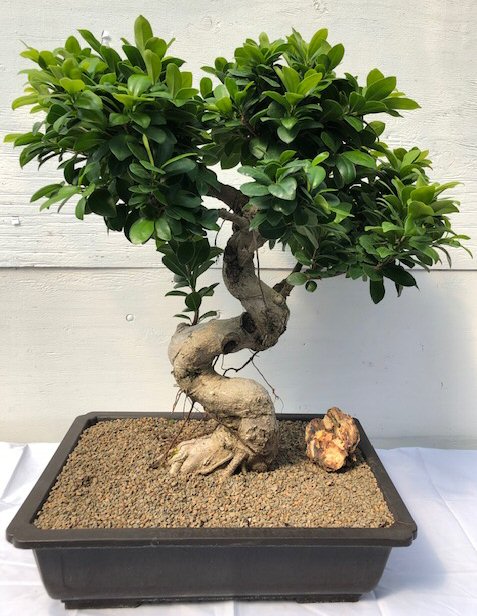
Fruiting Green Emerald Ficus Bonsai Tree
(ficus macrocarpa)
- Small leaves: One of the distinctive characteristics of Bonsai Figs is their small-sized leaves. Compared to their full-sized counterparts in nature, bonsai fig leaves are proportionately reduced to fit the miniature scale of the tree. The small leaves add to the overall visual appeal of the bonsai, creating a sense of harmony and balance in the tree’s design.
- Aerial roots: Bonsai Figs have a fascinating ability to develop aerial roots, which are roots that grow above the ground and dangle from the branches or trunk of the tree. These roots often begin as small protrusions and gradually elongate over time. Aerial roots not only enhance the aesthetic beauty of the bonsai but also provide an intriguing visual element, mimicking the natural growth patterns of fig trees in their native habitats.
Aerial roots in Bonsai Figs can be encouraged through specific cultivation techniques such as air layering or allowing the roots to grow freely from the branches. Some bonsai artists incorporate these aerial roots into the overall design, allowing them to cascade down the trunk or intertwine with the branches.
Discussion of the variety of Bonsai Fig species offered
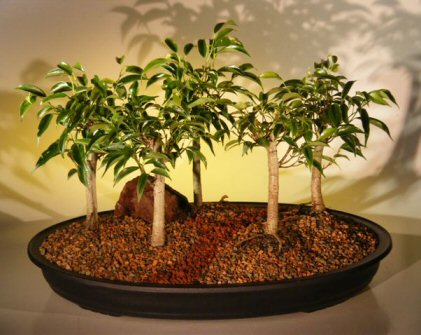
Oriental Ficus Bonsai Tree
Five (5) Tree Forest Group
(benjamina ‘orientalis’)
from: Bonsai Boy of New York
A variety of Bonsai Fig species to choose from. The specific selection may vary depending on the store and availability.
- Ficus microcarpa: Also known as the Chinese Banyan or Ginseng Ficus, this species is often favored for bonsai cultivation due to its compact size, small leaves, and aerial root development.
- Ficus retusa: Commonly known as the Indian Laurel or Taiwan Ficus, this species features shiny, dark green leaves and is valued for its ability to develop aerial roots, creating an intriguing visual display in bonsai form.
- Ficus benjamina: Also called the Weeping Fig, this species is characterized by its graceful, drooping branches and glossy, elliptical leaves. It is a popular choice for bonsai enthusiasts due to its elegant appearance.
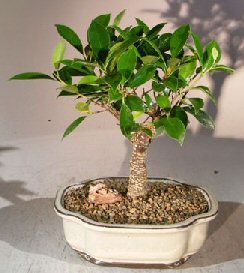
Ficus Retusa Bonsai Tree – Medium
(Ficus Retusa)
from: Bonsai Boy of New York
It’s important to note that the availability of specific Bonsai Fig species can vary depending on the store and time of year.
Care and Maintenance of Bonsai Figs
Overview of basic care requirements, including light, watering, and pruning: Bonsai Figs have specific care requirements to ensure their health and development. Here’s an overview of their basic care needs:
- Light: Bonsai Figs thrive in bright, indirect light. They prefer a location with ample natural sunlight but should be protected from intense, direct sunlight, especially during the hottest part of the day. Providing them with a balance of sunlight and shade is crucial for their growth and leaf development.
- Watering: Bonsai Figs require regular watering to maintain proper moisture levels. The frequency of watering will depend on factors such as temperature, humidity, and soil type. It’s essential to water thoroughly, allowing the water to soak the entire root system, and then let the soil partially dry before the next watering. Avoid overwatering, as it can lead to root rot.
- Pruning: Regular pruning is necessary to maintain the desired shape and size of the Bonsai Fig. Prune back new growth to encourage branching and maintain the overall design. Remove any dead, diseased, or crossing branches to promote airflow and prevent potential issues.
Tips on shaping and styling Bonsai Figs
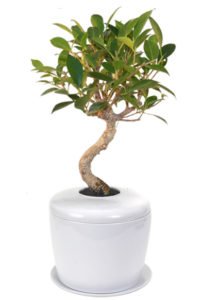
Ficus Retusa Curved Trunk Bonsai Tree &
Porcelain Ceramic Cremation Urn
with Matching Humidity / Drip Tray
Shaping and styling Bonsai Figs is an important aspect of their care and maintenance. Here are a few tips:
- Wiring: Wiring can be used to guide the growth and shape of branches in Bonsai Figs. Use aluminum or copper wire to gently bend and position the branches. Be cautious not to wire too tightly to avoid damaging the branches.
- Leaf pruning: Bonsai Figs often have vigorous growth, and their leaves can become large. Regular leaf pruning involves selectively removing or trimming larger leaves to maintain a more proportional and refined appearance. This can be done with sharp pruning shears or scissors.
- Styling: Bonsai Figs can be styled in various traditional bonsai styles, such as formal upright, cascade, or informal upright. Consider the natural growth habit of the tree and its unique characteristics when deciding on the styling direction.
Mention of available resources for Bonsai Fig care:
- Bonsai Tools: such as pruning shears, scissors, and branch cutters. These tools are essential for pruning, leaf trimming, and shaping Bonsai Figs.
- Bonsai Pots and Soil: bonsai pots and bonsai soil mixes suitable for Bonsai Figs. Choosing the right pot size and appropriate soil mix is important for proper drainage and root health.
- Bonsai Care Products: bonsai-specific care products, such as fertilizers, organic soil conditioners, and pest control solutions. These products can help provide the necessary nutrients and protect the health of Bonsai Figs.
Explanation of the Juniper genus and its various species:
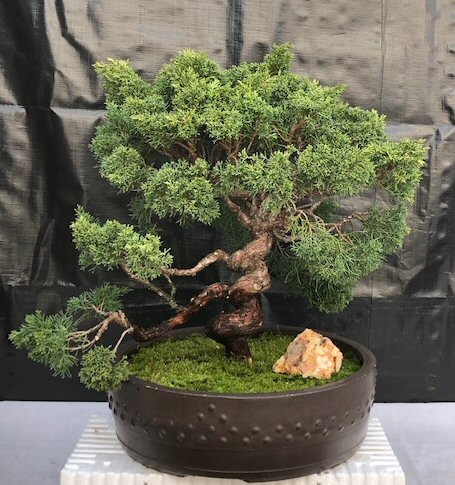
Shimpaku Juniper Bonsai Tree
Trained With Coiled Trunk & Coiled Branches
(juniper chinensis ‘shimpaku’)
Junipers are coniferous trees that belong to the Juniperus genus. They are highly sought after for bonsai due to their distinctive foliage, rugged appearance, and adaptability to bonsai techniques. Some popular species used for bonsai include the Juniperus procumbens, Juniperus chinensis, and Juniperus squamata.Junipers are characterized by their needle-like foliage, which can vary in color from deep green to blue-green or even golden hues, depending on the species and cultivar.
They often have attractive bark with interesting textures and can develop twisted or gnarled trunks over time. Junipers are hardy trees that can tolerate a wide range of climates and are suitable for both indoor and outdoor cultivation. They prefer well-draining soil and require regular watering, allowing the soil to dry slightly between waterings. Junipers respond well to pruning, wiring, and shaping techniques, making them versatile for various bonsai styles such as informal upright, slanting, or windswept.
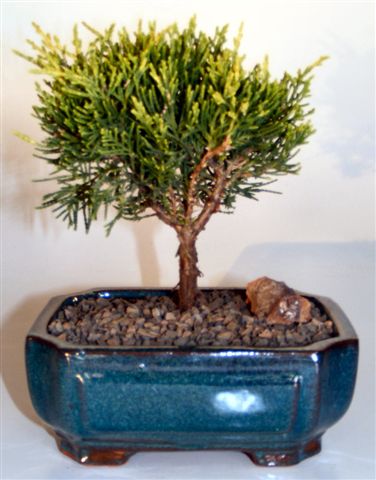
Golden Joy Shimpaku Juniper
(juniperus pfitzeriana)
The Juniper genus, known scientifically as Juniperus, is a diverse group of coniferous plants that belongs to the cypress family, Cupressaceae. It includes a wide range of species that are distributed across different regions of the world, including North America, Europe, Asia, and Africa. Some common species of Juniperus include Juniperus communis, Juniperus chinensis, Juniperus virginiana, and Juniperus scopulorum.
Each species within the Juniperus genus has its own unique characteristics in terms of size, growth habit, foliage color, and cone structure. They vary in their adaptability to different climates and environmental conditions, which makes them versatile for bonsai cultivation.
Characteristics of Junipers
Junipers are recognized for their distinctive characteristics, which contribute to their appeal as bonsai trees. Here are a few key features:
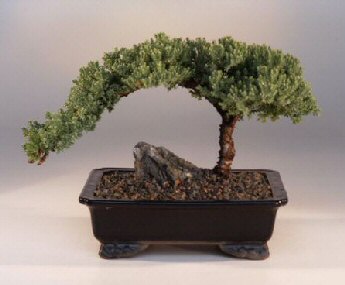
FREE SHIPPING ON THIS TREE
Juniper Bonsai Tree – Large
(Juniper Procumbens nana)
- Needle-like foliage: Junipers are known for their needle-like or scale-like foliage, which varies in color and texture depending on the species. The foliage can range from deep green to blue-green or even golden hues. The foliage provides an attractive evergreen aspect to the trees, adding year-round visual interest.
- Coniferous nature: Junipers are conifers, which means they are cone-bearing plants. The female Juniper trees produce small, berry-like cones that typically take a year or more to ripen. The cones are often inconspicuous and may not be a prominent feature in bonsai specimens. However, they add a touch of natural authenticity to the overall appearance of the tree.
- Bark and trunk texture: Junipers often have unique bark characteristics, with some species displaying exfoliating or peeling bark, while others have smooth or rough textures. The trunk of Junipers can vary from straight and upright to gnarled or twisted, providing an aged and weathered appearance that is highly sought after in bonsai aesthetics.
- Drought tolerance: Junipers are known for their ability to tolerate dry conditions. They have adapted to survive in various climates, including arid regions. This characteristic makes them well-suited for bonsai cultivation, as they require less frequent watering compared to some other tree species.
- Adaptability: Junipers are highly adaptable trees that can be grown both indoors and outdoors, depending on the specific species and local climate. They can thrive in a variety of soil types, including well-draining bonsai soil mixes.
Discussion of the variety of Juniper species offered
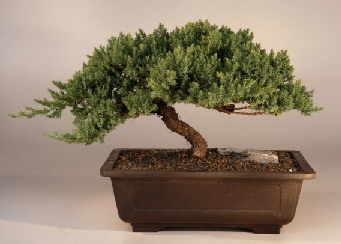
Juniper Windswept – Extra Large
(juniper procumbens ‘nana’)
- Juniperus chinensis: Also known as Chinese Juniper, this species is widely cultivated for bonsai. It has a variety of cultivars available, each with its own growth habit, foliage color, and texture.
- Juniperus procumbens: Commonly referred to as the Japanese Garden Juniper or Green Mound Juniper, this species is valued for its low, spreading growth habit and attractive, dark green foliage. It is a popular choice for creating cascading or semi-cascade styles in bonsai.
- Juniperus squamata: Known as the Flaky Juniper, this species is appreciated for its scale-like foliage and interesting bark texture. It is often used to create bonsai with an aged and weathered appearance.
- Juniperus virginiana: Also called Eastern Red Cedar, this species is native to North America. It features dense foliage, reddish-brown bark, and small cones. Juniperus virginiana can be shaped into various bonsai styles, including informal upright or windswept.
Care and Maintenance of Junipers
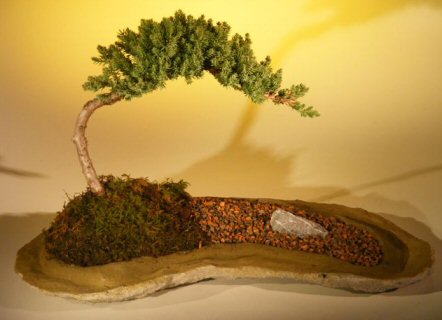
Juniper Bonsai Tree
Planted on a Rock Slab
(juniper procumbens nana)
Overview of basic care requirements, including light, watering, and soil needs: Junipers are relatively low-maintenance trees that thrive in outdoor environments. Here’s an overview of their basic care requirements:
- Light: Junipers prefer full sun and thrive in locations with direct sunlight for at least 6 hours a day. They require ample light to maintain their health, compact growth, and vibrant foliage colors.
- Watering: Junipers have moderate water needs. It’s important to water them thoroughly when the soil starts to dry out, but allow the soil to partially dry between waterings to avoid overwatering. Ensure the water reaches the entire root system. During the dormant season, reduce watering frequency.
- Soil: Junipers prefer well-draining soil that allows excess water to escape easily. Bonsai-specific soil mixes with a blend of organic matter and inorganic components work well for Juniper bonsai. Home Depot typically carries bonsai soil mixes suitable for Junipers.
- Fertilization: Junipers benefit from regular fertilization during the growing season. You can use a balanced, slow-release bonsai fertilizer or liquid fertilizer specifically formulated for evergreen trees. Follow the instructions on the fertilizer packaging for proper application.
Tips on shaping and wiring Juniper bonsai trees
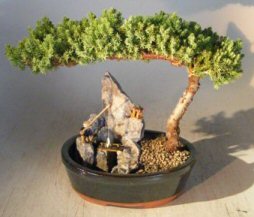
Juniper Bonsai Tree – Large
Stone Landscape Scene
(juniper procumbens nana)
- Shaping and wiring are crucial techniques in developing and styling Juniper bonsai trees. Here are a few tips:
- Pruning: Regular pruning helps maintain the desired shape and promotes branching. Trim back new growth to maintain the tree’s overall design and remove any dead or weak branches. Junipers can tolerate aggressive pruning, but avoid removing more than 1/3 of the foliage in a single season.
- Wiring: Wiring is commonly used to shape and position branches in Juniper bonsai. It’s best to wire Junipers during the dormant season when they are less susceptible to damage. Use aluminum or copper wire, and be cautious not to wire too tightly to avoid damaging the branches. Monitor the wire regularly to prevent it from cutting into the bark as the tree grows.
- Styling: Junipers can be styled in various traditional bonsai styles, including upright, cascade, slanting, or windswept. Consider the natural growth habit and characteristics of the tree when determining the styling direction. Regular pruning and wiring will help achieve the desired style over time.
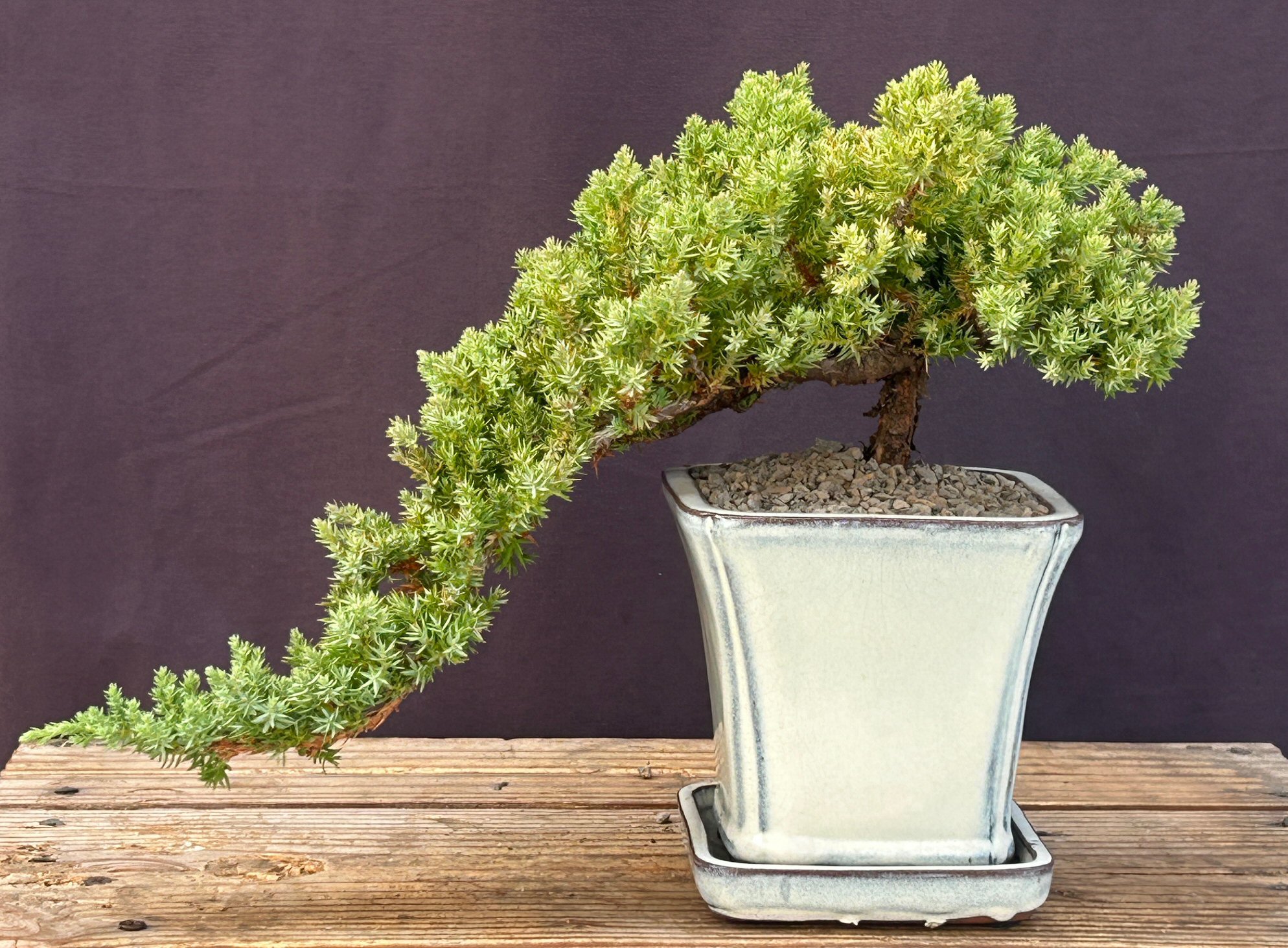
Juniper – Cascade Style
Mention of available resources at for Juniper bonsai care:
- Bonsai Tools: Home Depot typically carries a selection of bonsai tools, such as pruning shears, branch cutters, and wire cutters. These tools are essential for pruning, wiring, and maintaining Juniper bonsai trees.
- Bonsai Pots and Soil: Home Depot offers bonsai pots in various sizes and styles that are suitable for Juniper bonsai. They may also have bonsai soil mixes specifically designed for optimal drainage and root health.
- Bonsai Care Products: Home Depot may provide bonsai-specific care products, such as fertilizers, organic soil conditioners, and pest control solutions. These products can help nourish the Juniper bonsai and maintain its overall health.
Conclusion
Bonsai Figs, with their small leaves and aerial roots, provide an aesthetic appeal and a unique charm to any bonsai collection. Junipers, known for their needle-like foliage and coniferous nature, offer a classic and timeless beauty. Both Bonsai Figs and Junipers require specific care and maintenance, including proper lighting, watering, pruning, and shaping techniques. www.bonsaiboy.com provides a range of resources, such as bonsai tools, pots, soil, and care products, to support the health and development of these bonsai trees.